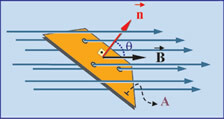A metal detector basically consists of a coil wrapped around an iron core. The coil is traveled by a certain electrical current, which generates a magnetic field. A coil is a set of conductive waits.
When the detector is approached to a metallic object, there is a variation in the magnetic flux through the object, inducing electrical currents in it (eddy currents).
These currents generate a variable magnetic field, which induces a current in the coil, of different intensity than the one that travels through it.
According to electromagnetism, when the magnetic flux varies on the surface of a coil, an electric current arises, called induced current, and the direction of the induced current is such that, by its effects, it opposes the tail that gave it It is made.
This variation in current is registered by an ammeter which, in turn, indicates the presence of the metallic object, through an audible alarm.
The basic principle of manufacturing metal detectors is the same as manufacturing transformers, microphone, speakers, etc.
By Kléber Cavalcante
Graduated in Physics
Source: Brazil School - https://brasilescola.uol.com.br/fisica/como-funciona-detector-metais.htm

